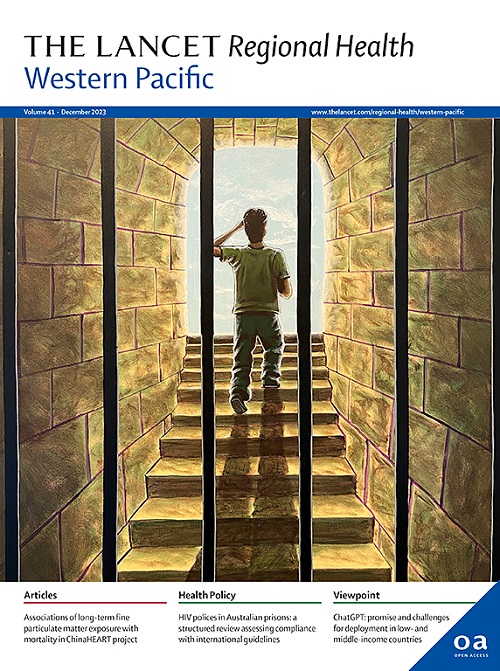Characteristics and outcomes in atorvastatin therapy for chronic subdural hematoma: a national, observational real-world study in China, 2019–2024
IF 8.1
1区 医学
Q1 HEALTH CARE SCIENCES & SERVICES
引用次数: 0
Abstract
Background
The incidence of chronic subdural hematoma (cSDH) is increasing in the aging population worldwide, where the success of conventional surgical decompression is complicated by high rates of complications and recurrence. The anti-inflammatory properties of atorvastatin make it an attractive, low-cost, and safe medical approach, but limited evidence exists regarding its clinical benefit in cSDH. We aim to evaluate temporal trends, disease characteristics, and clinical outcomes associated with atorvastatin treatment for cSDH in real-world settings in China.
Methods
This was a multicenter registry study of the Chronic Subdural Hematoma (MR-CSDH) in China. Adults received either 20 mg of atorvastatin or not daily for 8 weeks and were followed up for an additional 6 months at 61 medical centers between November 1, 2019 and October 30, 2024. The primary outcome was good functional outcome defined by modified Rankin scale scores of 0–3 at 6 months. Secondary outcomes included good clinical outcomes and recurrence at 3 months, mortality and recurrent SDH at 6 months, healthcare costs, suspected statin-related adverse events, and length of hospital stay. Logistic regression and propensity score matching (PSM) were used for analysis. The trial was registered with Chinese Clinical Trial Registry, identifier ChiCTR2200057179.
Findings
A total of 2422 patients were included (mean [SD] age: 70.3 [14.5] years; 453 [18.7%] female), of whom 1777 (73.4%) received atorvastatin therapy. The proportion of cSDH patients receiving conservative treatment tripled, rising from 14.7% in 2019 to 53.4% in 2024 (P for trend <0.001), while the proportion undergoing surgical treatment significantly declined (P < 0.001). Moreover, the proportion of cSDH patients prescribed statin medication showed a steady temporal increase. Compared to patients who did not receive atorvastatin, those treated with atorvastatin had a higher likelihood of good functional outcome (odds ratio 1.93, 95% confidence interval [CI] 1.29–2.89), lower risk of mortality (hazard ratio 0.24, 95% CI 0.06–0.92) at 6 months, and reduced length of hospital stay (mean difference [MD] −1.69, 95% CI [−3.01, −0.37], P = 0.012) and decreased hospitalization costs (MD −0.79, 95% CI [−1.31, −0.28], P = 0.003). However, the between-group differences in recurrent SDH (at 3 and 6 months) and adverse events were not significantly different.
Interpretation
This study indicates a positive association between atorvastatin use and good clinical outcomes in patients with cSDH, and is increasingly being used in China.
Funding
This study was funded by the National Natural Science Foundation of China (No. 82071390, 82001323, 82101434), the Science and Technology Project of Tianjin (No. 19YFZCSY00650), Tianjin Key Medical Discipline (Specialty) Construction Project, and the Zhao Yi-Cheng Medical Science Foundation.
阿托伐他汀治疗慢性硬膜下血肿的特点和结果:2019-2024年在中国进行的一项全国性、观察性现实世界研究
背景:慢性硬膜下血肿(cSDH)在全球老龄化人群中的发病率正在增加,其中传统手术减压的成功率因并发症和复发率高而变得复杂。阿托伐他汀的抗炎特性使其成为一种有吸引力、低成本和安全的医疗方法,但关于其在cSDH中的临床益处的证据有限。我们的目的是评估中国现实环境中与阿托伐他汀治疗cSDH相关的时间趋势、疾病特征和临床结果。方法:这是一项中国慢性硬膜下血肿(MR-CSDH)的多中心注册研究。成年人每天接受20mg阿托伐他汀或不接受20mg阿托伐他汀,持续8周,并在2019年11月1日至2024年10月30日期间在61个医疗中心进行了额外的6个月随访。6个月时,主要结果为良好的功能结果,由修改的Rankin量表评分0-3分定义。次要结局包括良好的临床结局和3个月时的复发、6个月时的死亡率和复发性SDH、医疗费用、疑似他汀类药物相关不良事件和住院时间。采用Logistic回归和倾向评分匹配(PSM)进行分析。该试验已在中国临床试验注册中心注册,注册号为ChiCTR2200057179。结果共纳入2422例患者(平均[SD]年龄:70.3[14.5]岁;女性453例[18.7%]),其中1777例(73.4%)患者接受了阿托伐他汀治疗。cSDH患者接受保守治疗的比例从2019年的14.7%上升到2024年的53.4% (P为趋势P <;0.001),增加了两倍,而接受手术治疗的比例明显下降(P <0.001)。此外,服用他汀类药物的cSDH患者比例呈稳定的时间增长趋势。与未接受阿托伐他汀治疗的患者相比,接受阿托伐他汀治疗的患者在6个月时获得良好功能结局的可能性更高(优势比1.93,95%可信区间[CI] 1.29-2.89),死亡风险更低(风险比0.24,95% CI 0.06-0.92),住院时间缩短(平均差异[MD] - 1.69, 95% CI [- 3.01, - 0.37], P = 0.012),住院费用降低(MD - 0.79, 95% CI [- 1.31, - 0.28], P = 0.003)。然而,复发性SDH(3个月和6个月)和不良事件的组间差异无显著性差异。本研究表明,在cSDH患者中使用阿托伐他汀与良好的临床结果呈正相关,并且在中国越来越多地使用阿托伐他汀。本研究由国家自然科学基金项目(No. 82071390, 82001323, 82101434)、天津市科技计划项目(No. 19YFZCSY00650)、天津市医学重点学科(专业)建设项目和赵义成医学科学基金资助。
本文章由计算机程序翻译,如有差异,请以英文原文为准。
求助全文
约1分钟内获得全文
求助全文
来源期刊

The Lancet Regional Health: Western Pacific
Medicine-Pediatrics, Perinatology and Child Health
CiteScore
8.80
自引率
2.80%
发文量
305
审稿时长
11 weeks
期刊介绍:
The Lancet Regional Health – Western Pacific, a gold open access journal, is an integral part of The Lancet's global initiative advocating for healthcare quality and access worldwide. It aims to advance clinical practice and health policy in the Western Pacific region, contributing to enhanced health outcomes. The journal publishes high-quality original research shedding light on clinical practice and health policy in the region. It also includes reviews, commentaries, and opinion pieces covering diverse regional health topics, such as infectious diseases, non-communicable diseases, child and adolescent health, maternal and reproductive health, aging health, mental health, the health workforce and systems, and health policy.
 求助内容:
求助内容: 应助结果提醒方式:
应助结果提醒方式:


